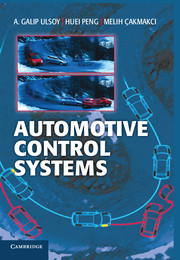Book contents
- Frontmatter
- Contents
- Preface
- Part I Introduction and Background
- Part II Powertrain Control Systems
- Part III Vehicle Control Systems
- 12 Cruise and Headway Control
- 13 Antilock Brake and Traction-Control Systems
- 14 Vehicle Stability Control
- 15 Four-Wheel Steering
- 16 Active Suspensions
- Part IV Intelligent Transportation Systems
- Appendices
- Index
- References
14 - Vehicle Stability Control
Published online by Cambridge University Press: 05 June 2012
- Frontmatter
- Contents
- Preface
- Part I Introduction and Background
- Part II Powertrain Control Systems
- Part III Vehicle Control Systems
- 12 Cruise and Headway Control
- 13 Antilock Brake and Traction-Control Systems
- 14 Vehicle Stability Control
- 15 Four-Wheel Steering
- 16 Active Suspensions
- Part IV Intelligent Transportation Systems
- Appendices
- Index
- References
Summary
The concept of vehicle stability control (VSC), variously known as vehicle dynamics control (VDC) and electronic stability program (ESP), was first introduced in 1995 and has been studied extensively as an active safety device to improve vehicle stability and handling. The concepts are natural extensions of the ABS and TCS discussed in Chapter 13. When “differential braking” is applied – that is, braking forces of the left- and right-hand-side tires are different – a yaw moment is generated. This yaw moment then slows down the vehicle and influences the vehicle lateral/yaw/roll motion. By taking advantage of the widely available and mature ABS hardware, this differential braking function is added on with minimal additional cost. Therefore, this vehicle control system has enjoyed rapid market acceptance.
The vehicle yaw moment also can be generated through the manipulation of tire-traction forces – for example, through the control of differentials or power-split devices in AWD vehicles (Piyabongkarn et al. 2010). In such systems, the objectives of VSC can be achieved without reducing the longitudinal velocity – but at the cost of additional hardware. Vehicle-handling performance can be influenced by many different actuations. In addition to differential braking and traction, all-wheel steering and active/semi-active suspensions (including antiroll systems) can be used. Hac and Bodie (2002) discussed methods for improving vehicle stability and emergency handling using electronically controlled chassis systems. Small changes in the balance of tire forces between the front and rear axles may affect vehicle yaw moment and stability. They discuss methods of affecting vehicle-yaw dynamics using controllable brakes, steering, and suspension. Brake-steering techniques are discussed in detail in Pilutti et al. (1998).
- Type
- Chapter
- Information
- Automotive Control Systems , pp. 257 - 271Publisher: Cambridge University PressPrint publication year: 2012
References
- 1
- Cited by

